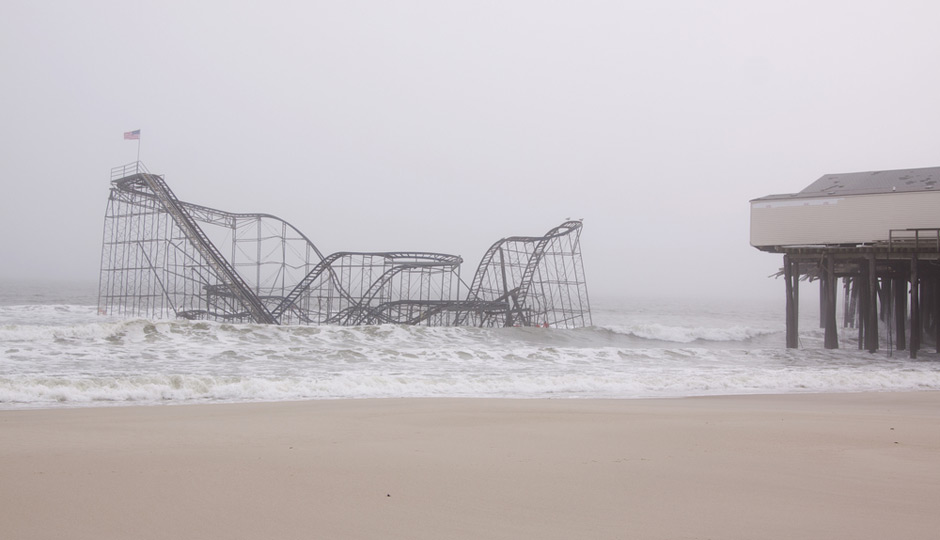Sandy: One Year Later
October 21st, 2012, was one of those impossibly gorgeous Jersey Shore days, where even though the thermometer said the temperature was in the 60s, the sun was so strong and warm that I stripped down to my tank top while watching the Atlantic City Marathon.
Later, when I was having drinks on the lawn of Congress Hall after their TEDx Cape May Conference, the talk wasn’t just of the beautiful weather that day, but of a maybe storm. I say “maybe” for a reason. These were lifetime shore residents, old salts really, who were used to this: The alarm would sound about a storm because forecasters showed it hitting New Jersey in one of a dozen possible storm paths. And then it would slam into Florida, turn out to sea, or just fizzle out.
Not this time.
Today is the anniversary of when Superstorm Sandy made landfall in Brigantine and ruined the lives of millions of people who live and love the Jersey Shore.
There is no other way to put it.
And the misery continues. Because despite pledges of unlimited support and help from the government—both federal and local—we haven’t hit rock bottom in the aftermath of one bitch of a hurricane.
Here are just three depressing examples:
- Many shore residents are still waiting on insurance checks so they can rebuild – yes a year later.
- Of the $600 million of the federal Reconstruction, Rehabilitation, Elevation and Mitigation grant program that is supposed to help Sandy-affected residents, only $7.8 million has been given out—and those agreements were just signed this month
- The federal government is investigating the no-bid contract given to Florida-based AshBritt by Gov. Christie for post-Sandy cleanup because they allegedly overcharged reeling shore towns for their services.
Despite that annoying jingle for which New Jersey residents paid $25 million (another Sandy-related controversy), we are not stronger than the storm.
Just look at beach tag sales. In Ocean County, sales dropped by 25 percent; in Monmouth County 10 percent. Brick’s beach tag sales dropped by 54 percent, and Tom’s River’s dropped a crushing 84 percent.
Some of that had to do with wet weather early in the season, but a lot of second homes that provide vacation rental spots in towns where hotels and motels are scarce, just didn’t come back because the same rebuilding grants weren’t available to them.
In a way, we were lucky at the South Jersey Shore, and relatively unscathed—and I say relatively given what’s going on in Ventnor Heights, how many empty homes still line the bay in Ocean City, and how homeowners are now grappling with spikes in flood insurance costs on both the shore and the bay.
But we didn’t have blocks of homes bulldozed like Ortley, and our roller coasters didn’t fall into the ocean like in Seaside. The causeways from the mainland onto our barrier islands didn’t wash away like in Mantoloking. And we didn’t lose a chunk of the Atlantic City or Ocean City or Avalon or Wildwood boardwalks because wires corroded by Sandy-pushed salt water lit them on fire.
Still, we all bear the psychological damage, and the worry that the next storm won’t be 50 years away, that climate change puts it more like 10 or five or one. Or that next time, the storm will make landfall in Rehoboth or Cape May. Because if Sandy had turned there, the entire Jersey Shore would have been slammed with ocean-front winds and storm surges instead of just areas above Brigantine. We’d have seen a very different South Jersey Shore left in the storm’s wake.
I was back in Cape May on October 20th of this year, again having drinks on the lawn of Congress Hall after TEDxCape May, and again it was one of those impossibly warm fall days, despite the 60-degree temperatures.
But instead of standing by the bar and talking with those same old salts, I sat on an Adirondack chair that faced right into the sun.
There was no storm threat this year, no talk of whether it would be the “big one.” I reminded myself while I sat there, with my eyes closed, that there would be no terror a week later when that premonition turned out to be true.
But the fear of the next big one is always going to be there now, even on an impossibly gorgeous day, with the sun on my face and the sound of the ocean in my ears. Which is why I sat on that chair that day. I want to savor every moment now, in case the next big one is the last big one.
I hope it never happens. I hope the predictions about more frequent and more violent storms are never realized—for the sake of my state, for my beloved Jersey Shore, and hundreds of gorgeous beach days to come.



